The Role of Brainstorming in Management and Problem-Solving Strategies
VerifiedAdded on 2023/06/03
|7
|2115
|231
Essay
AI Summary
This essay explores the concept of brainstorming as a problem-solving technique in management, emphasizing its role in generating creative ideas and fostering collaboration. It discusses various brainstorming techniques, such as the Stepladder technique and Starbursting, and highlights factors that contribute to successful brainstorming sessions. The essay also reflects on the author's learning experience, noting the benefits of brainstorming in enhancing problem-solving skills, increasing knowledge, and building confidence. It emphasizes the importance of open-mindedness, diverse perspectives, and effective facilitation in the brainstorming process, ultimately concluding that brainstorming is a valuable tool for generating innovative solutions and improving teamwork in management settings. Desklib provides access to similar essays and resources for students.
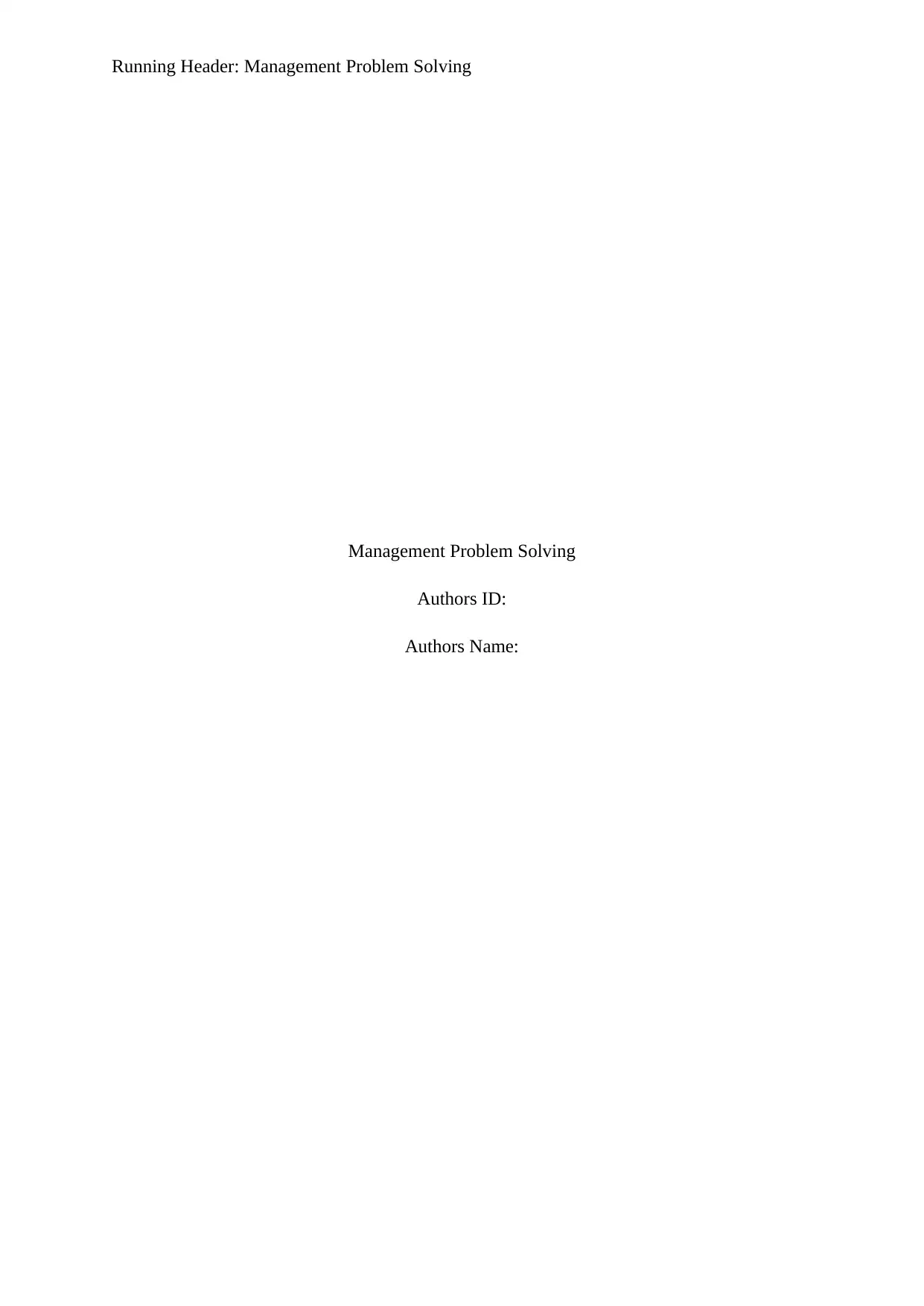
Running Header: Management Problem Solving
Management Problem Solving
Authors ID:
Authors Name:
Management Problem Solving
Authors ID:
Authors Name:
Paraphrase This Document
Need a fresh take? Get an instant paraphrase of this document with our AI Paraphraser
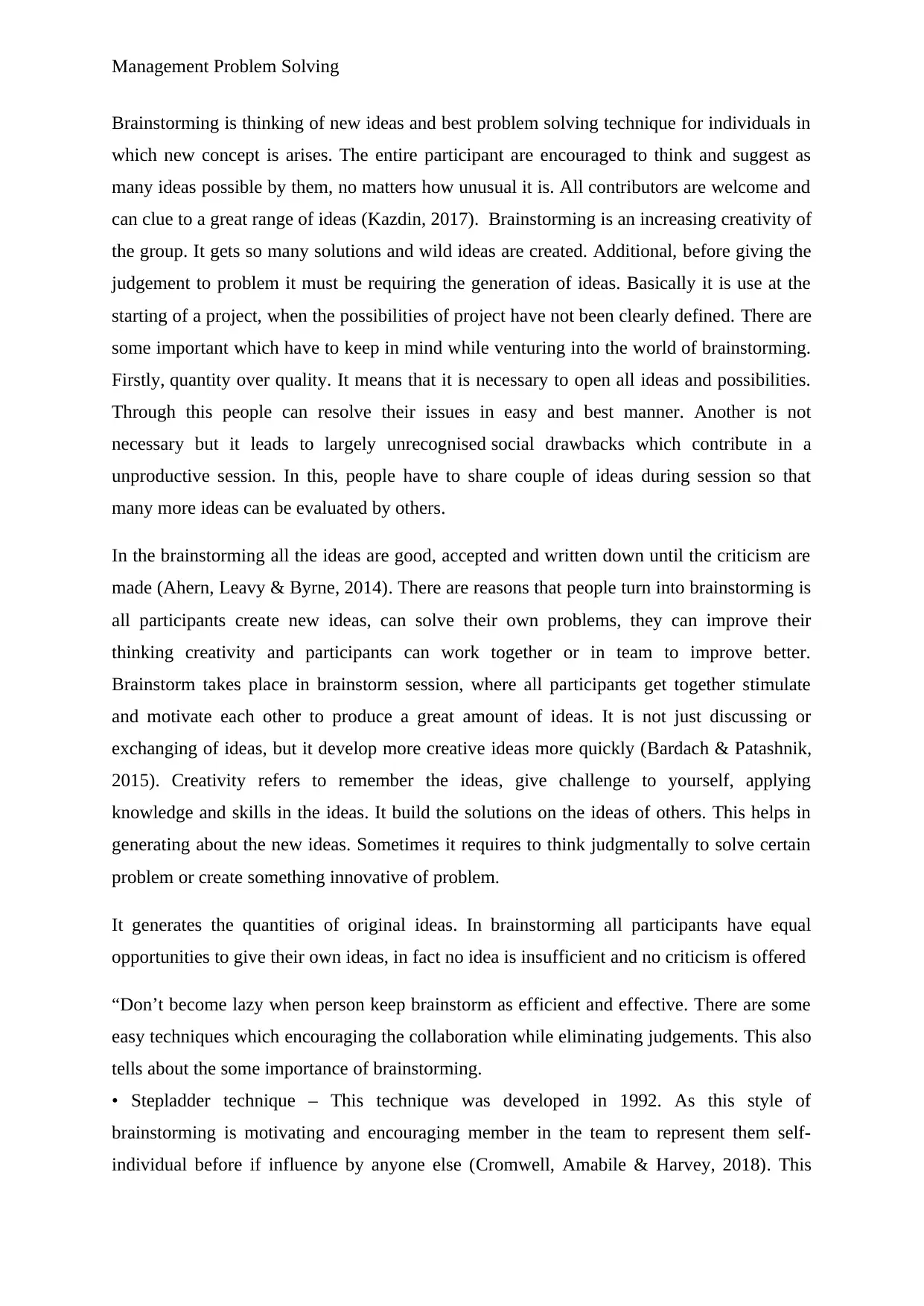
Management Problem Solving
Brainstorming is thinking of new ideas and best problem solving technique for individuals in
which new concept is arises. The entire participant are encouraged to think and suggest as
many ideas possible by them, no matters how unusual it is. All contributors are welcome and
can clue to a great range of ideas (Kazdin, 2017). Brainstorming is an increasing creativity of
the group. It gets so many solutions and wild ideas are created. Additional, before giving the
judgement to problem it must be requiring the generation of ideas. Basically it is use at the
starting of a project, when the possibilities of project have not been clearly defined. There are
some important which have to keep in mind while venturing into the world of brainstorming.
Firstly, quantity over quality. It means that it is necessary to open all ideas and possibilities.
Through this people can resolve their issues in easy and best manner. Another is not
necessary but it leads to largely unrecognised social drawbacks which contribute in a
unproductive session. In this, people have to share couple of ideas during session so that
many more ideas can be evaluated by others.
In the brainstorming all the ideas are good, accepted and written down until the criticism are
made (Ahern, Leavy & Byrne, 2014). There are reasons that people turn into brainstorming is
all participants create new ideas, can solve their own problems, they can improve their
thinking creativity and participants can work together or in team to improve better.
Brainstorm takes place in brainstorm session, where all participants get together stimulate
and motivate each other to produce a great amount of ideas. It is not just discussing or
exchanging of ideas, but it develop more creative ideas more quickly (Bardach & Patashnik,
2015). Creativity refers to remember the ideas, give challenge to yourself, applying
knowledge and skills in the ideas. It build the solutions on the ideas of others. This helps in
generating about the new ideas. Sometimes it requires to think judgmentally to solve certain
problem or create something innovative of problem.
It generates the quantities of original ideas. In brainstorming all participants have equal
opportunities to give their own ideas, in fact no idea is insufficient and no criticism is offered
“Don’t become lazy when person keep brainstorm as efficient and effective. There are some
easy techniques which encouraging the collaboration while eliminating judgements. This also
tells about the some importance of brainstorming.
• Stepladder technique – This technique was developed in 1992. As this style of
brainstorming is motivating and encouraging member in the team to represent them self-
individual before if influence by anyone else (Cromwell, Amabile & Harvey, 2018). This
Brainstorming is thinking of new ideas and best problem solving technique for individuals in
which new concept is arises. The entire participant are encouraged to think and suggest as
many ideas possible by them, no matters how unusual it is. All contributors are welcome and
can clue to a great range of ideas (Kazdin, 2017). Brainstorming is an increasing creativity of
the group. It gets so many solutions and wild ideas are created. Additional, before giving the
judgement to problem it must be requiring the generation of ideas. Basically it is use at the
starting of a project, when the possibilities of project have not been clearly defined. There are
some important which have to keep in mind while venturing into the world of brainstorming.
Firstly, quantity over quality. It means that it is necessary to open all ideas and possibilities.
Through this people can resolve their issues in easy and best manner. Another is not
necessary but it leads to largely unrecognised social drawbacks which contribute in a
unproductive session. In this, people have to share couple of ideas during session so that
many more ideas can be evaluated by others.
In the brainstorming all the ideas are good, accepted and written down until the criticism are
made (Ahern, Leavy & Byrne, 2014). There are reasons that people turn into brainstorming is
all participants create new ideas, can solve their own problems, they can improve their
thinking creativity and participants can work together or in team to improve better.
Brainstorm takes place in brainstorm session, where all participants get together stimulate
and motivate each other to produce a great amount of ideas. It is not just discussing or
exchanging of ideas, but it develop more creative ideas more quickly (Bardach & Patashnik,
2015). Creativity refers to remember the ideas, give challenge to yourself, applying
knowledge and skills in the ideas. It build the solutions on the ideas of others. This helps in
generating about the new ideas. Sometimes it requires to think judgmentally to solve certain
problem or create something innovative of problem.
It generates the quantities of original ideas. In brainstorming all participants have equal
opportunities to give their own ideas, in fact no idea is insufficient and no criticism is offered
“Don’t become lazy when person keep brainstorm as efficient and effective. There are some
easy techniques which encouraging the collaboration while eliminating judgements. This also
tells about the some importance of brainstorming.
• Stepladder technique – This technique was developed in 1992. As this style of
brainstorming is motivating and encouraging member in the team to represent them self-
individual before if influence by anyone else (Cromwell, Amabile & Harvey, 2018). This
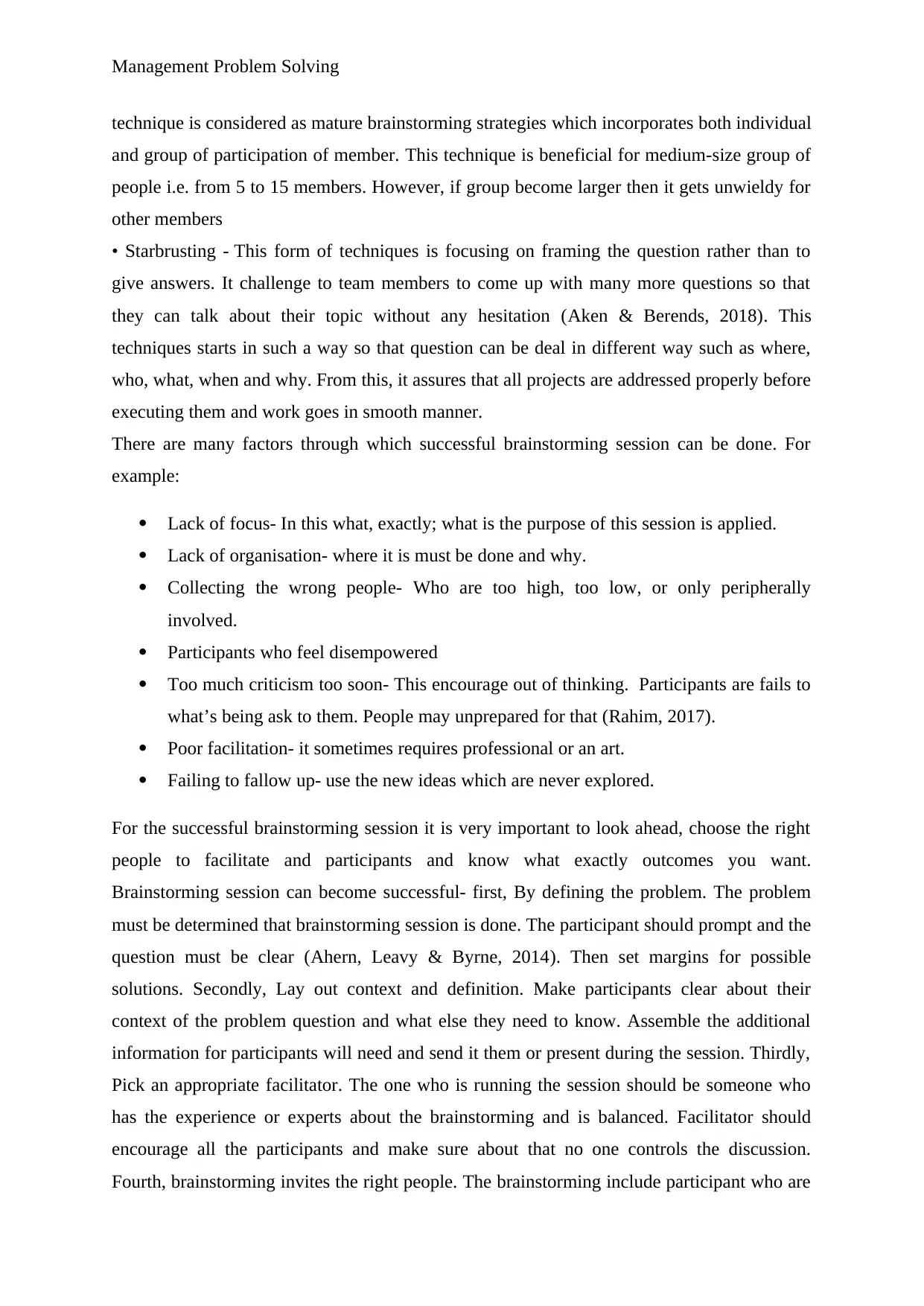
Management Problem Solving
technique is considered as mature brainstorming strategies which incorporates both individual
and group of participation of member. This technique is beneficial for medium-size group of
people i.e. from 5 to 15 members. However, if group become larger then it gets unwieldy for
other members
• Starbrusting - This form of techniques is focusing on framing the question rather than to
give answers. It challenge to team members to come up with many more questions so that
they can talk about their topic without any hesitation (Aken & Berends, 2018). This
techniques starts in such a way so that question can be deal in different way such as where,
who, what, when and why. From this, it assures that all projects are addressed properly before
executing them and work goes in smooth manner.
There are many factors through which successful brainstorming session can be done. For
example:
Lack of focus- In this what, exactly; what is the purpose of this session is applied.
Lack of organisation- where it is must be done and why.
Collecting the wrong people- Who are too high, too low, or only peripherally
involved.
Participants who feel disempowered
Too much criticism too soon- This encourage out of thinking. Participants are fails to
what’s being ask to them. People may unprepared for that (Rahim, 2017).
Poor facilitation- it sometimes requires professional or an art.
Failing to fallow up- use the new ideas which are never explored.
For the successful brainstorming session it is very important to look ahead, choose the right
people to facilitate and participants and know what exactly outcomes you want.
Brainstorming session can become successful- first, By defining the problem. The problem
must be determined that brainstorming session is done. The participant should prompt and the
question must be clear (Ahern, Leavy & Byrne, 2014). Then set margins for possible
solutions. Secondly, Lay out context and definition. Make participants clear about their
context of the problem question and what else they need to know. Assemble the additional
information for participants will need and send it them or present during the session. Thirdly,
Pick an appropriate facilitator. The one who is running the session should be someone who
has the experience or experts about the brainstorming and is balanced. Facilitator should
encourage all the participants and make sure about that no one controls the discussion.
Fourth, brainstorming invites the right people. The brainstorming include participant who are
technique is considered as mature brainstorming strategies which incorporates both individual
and group of participation of member. This technique is beneficial for medium-size group of
people i.e. from 5 to 15 members. However, if group become larger then it gets unwieldy for
other members
• Starbrusting - This form of techniques is focusing on framing the question rather than to
give answers. It challenge to team members to come up with many more questions so that
they can talk about their topic without any hesitation (Aken & Berends, 2018). This
techniques starts in such a way so that question can be deal in different way such as where,
who, what, when and why. From this, it assures that all projects are addressed properly before
executing them and work goes in smooth manner.
There are many factors through which successful brainstorming session can be done. For
example:
Lack of focus- In this what, exactly; what is the purpose of this session is applied.
Lack of organisation- where it is must be done and why.
Collecting the wrong people- Who are too high, too low, or only peripherally
involved.
Participants who feel disempowered
Too much criticism too soon- This encourage out of thinking. Participants are fails to
what’s being ask to them. People may unprepared for that (Rahim, 2017).
Poor facilitation- it sometimes requires professional or an art.
Failing to fallow up- use the new ideas which are never explored.
For the successful brainstorming session it is very important to look ahead, choose the right
people to facilitate and participants and know what exactly outcomes you want.
Brainstorming session can become successful- first, By defining the problem. The problem
must be determined that brainstorming session is done. The participant should prompt and the
question must be clear (Ahern, Leavy & Byrne, 2014). Then set margins for possible
solutions. Secondly, Lay out context and definition. Make participants clear about their
context of the problem question and what else they need to know. Assemble the additional
information for participants will need and send it them or present during the session. Thirdly,
Pick an appropriate facilitator. The one who is running the session should be someone who
has the experience or experts about the brainstorming and is balanced. Facilitator should
encourage all the participants and make sure about that no one controls the discussion.
Fourth, brainstorming invites the right people. The brainstorming include participant who are
⊘ This is a preview!⊘
Do you want full access?
Subscribe today to unlock all pages.

Trusted by 1+ million students worldwide
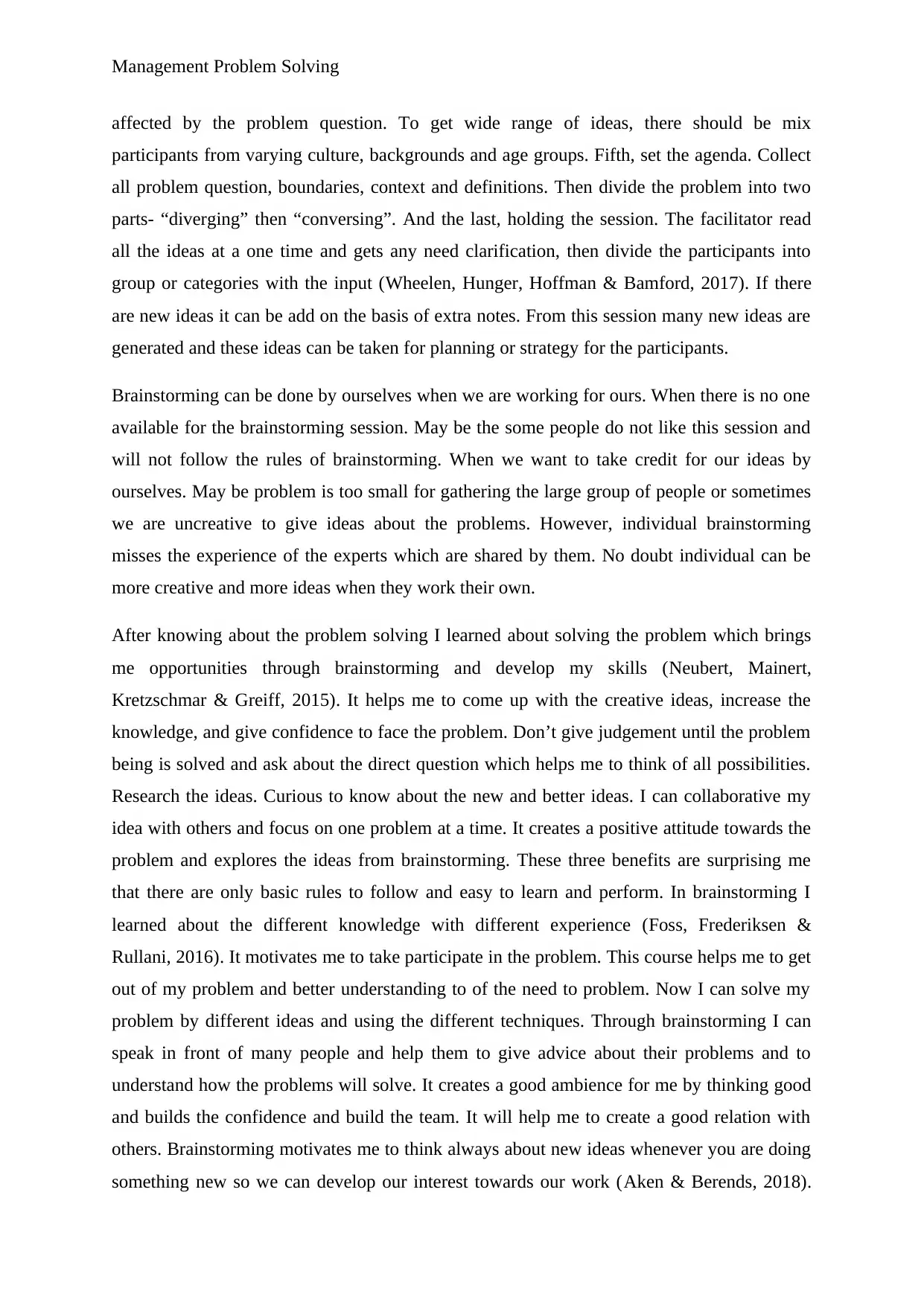
Management Problem Solving
affected by the problem question. To get wide range of ideas, there should be mix
participants from varying culture, backgrounds and age groups. Fifth, set the agenda. Collect
all problem question, boundaries, context and definitions. Then divide the problem into two
parts- “diverging” then “conversing”. And the last, holding the session. The facilitator read
all the ideas at a one time and gets any need clarification, then divide the participants into
group or categories with the input (Wheelen, Hunger, Hoffman & Bamford, 2017). If there
are new ideas it can be add on the basis of extra notes. From this session many new ideas are
generated and these ideas can be taken for planning or strategy for the participants.
Brainstorming can be done by ourselves when we are working for ours. When there is no one
available for the brainstorming session. May be the some people do not like this session and
will not follow the rules of brainstorming. When we want to take credit for our ideas by
ourselves. May be problem is too small for gathering the large group of people or sometimes
we are uncreative to give ideas about the problems. However, individual brainstorming
misses the experience of the experts which are shared by them. No doubt individual can be
more creative and more ideas when they work their own.
After knowing about the problem solving I learned about solving the problem which brings
me opportunities through brainstorming and develop my skills (Neubert, Mainert,
Kretzschmar & Greiff, 2015). It helps me to come up with the creative ideas, increase the
knowledge, and give confidence to face the problem. Don’t give judgement until the problem
being is solved and ask about the direct question which helps me to think of all possibilities.
Research the ideas. Curious to know about the new and better ideas. I can collaborative my
idea with others and focus on one problem at a time. It creates a positive attitude towards the
problem and explores the ideas from brainstorming. These three benefits are surprising me
that there are only basic rules to follow and easy to learn and perform. In brainstorming I
learned about the different knowledge with different experience (Foss, Frederiksen &
Rullani, 2016). It motivates me to take participate in the problem. This course helps me to get
out of my problem and better understanding to of the need to problem. Now I can solve my
problem by different ideas and using the different techniques. Through brainstorming I can
speak in front of many people and help them to give advice about their problems and to
understand how the problems will solve. It creates a good ambience for me by thinking good
and builds the confidence and build the team. It will help me to create a good relation with
others. Brainstorming motivates me to think always about new ideas whenever you are doing
something new so we can develop our interest towards our work (Aken & Berends, 2018).
affected by the problem question. To get wide range of ideas, there should be mix
participants from varying culture, backgrounds and age groups. Fifth, set the agenda. Collect
all problem question, boundaries, context and definitions. Then divide the problem into two
parts- “diverging” then “conversing”. And the last, holding the session. The facilitator read
all the ideas at a one time and gets any need clarification, then divide the participants into
group or categories with the input (Wheelen, Hunger, Hoffman & Bamford, 2017). If there
are new ideas it can be add on the basis of extra notes. From this session many new ideas are
generated and these ideas can be taken for planning or strategy for the participants.
Brainstorming can be done by ourselves when we are working for ours. When there is no one
available for the brainstorming session. May be the some people do not like this session and
will not follow the rules of brainstorming. When we want to take credit for our ideas by
ourselves. May be problem is too small for gathering the large group of people or sometimes
we are uncreative to give ideas about the problems. However, individual brainstorming
misses the experience of the experts which are shared by them. No doubt individual can be
more creative and more ideas when they work their own.
After knowing about the problem solving I learned about solving the problem which brings
me opportunities through brainstorming and develop my skills (Neubert, Mainert,
Kretzschmar & Greiff, 2015). It helps me to come up with the creative ideas, increase the
knowledge, and give confidence to face the problem. Don’t give judgement until the problem
being is solved and ask about the direct question which helps me to think of all possibilities.
Research the ideas. Curious to know about the new and better ideas. I can collaborative my
idea with others and focus on one problem at a time. It creates a positive attitude towards the
problem and explores the ideas from brainstorming. These three benefits are surprising me
that there are only basic rules to follow and easy to learn and perform. In brainstorming I
learned about the different knowledge with different experience (Foss, Frederiksen &
Rullani, 2016). It motivates me to take participate in the problem. This course helps me to get
out of my problem and better understanding to of the need to problem. Now I can solve my
problem by different ideas and using the different techniques. Through brainstorming I can
speak in front of many people and help them to give advice about their problems and to
understand how the problems will solve. It creates a good ambience for me by thinking good
and builds the confidence and build the team. It will help me to create a good relation with
others. Brainstorming motivates me to think always about new ideas whenever you are doing
something new so we can develop our interest towards our work (Aken & Berends, 2018).
Paraphrase This Document
Need a fresh take? Get an instant paraphrase of this document with our AI Paraphraser
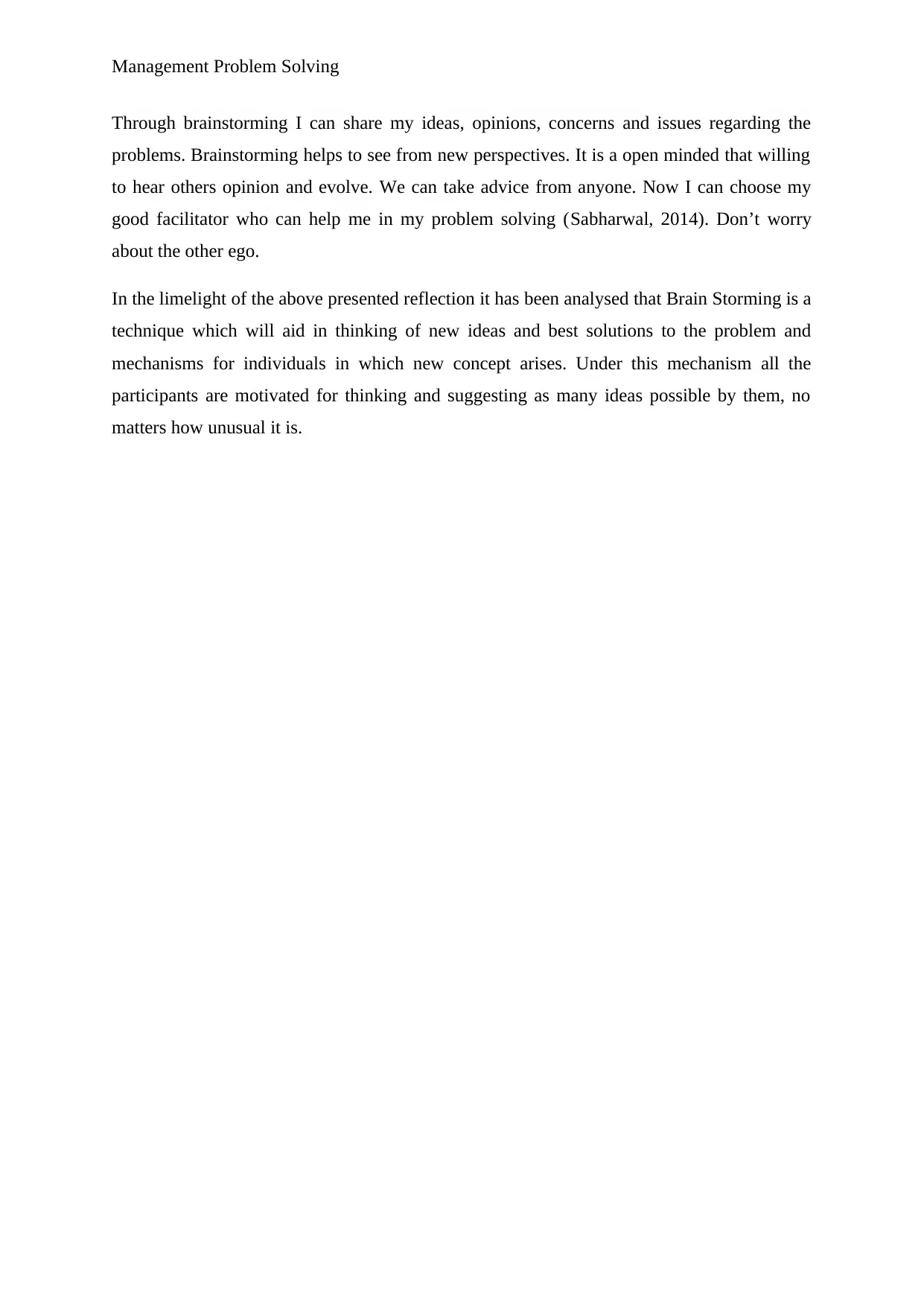
Management Problem Solving
Through brainstorming I can share my ideas, opinions, concerns and issues regarding the
problems. Brainstorming helps to see from new perspectives. It is a open minded that willing
to hear others opinion and evolve. We can take advice from anyone. Now I can choose my
good facilitator who can help me in my problem solving (Sabharwal, 2014). Don’t worry
about the other ego.
In the limelight of the above presented reflection it has been analysed that Brain Storming is a
technique which will aid in thinking of new ideas and best solutions to the problem and
mechanisms for individuals in which new concept arises. Under this mechanism all the
participants are motivated for thinking and suggesting as many ideas possible by them, no
matters how unusual it is.
Through brainstorming I can share my ideas, opinions, concerns and issues regarding the
problems. Brainstorming helps to see from new perspectives. It is a open minded that willing
to hear others opinion and evolve. We can take advice from anyone. Now I can choose my
good facilitator who can help me in my problem solving (Sabharwal, 2014). Don’t worry
about the other ego.
In the limelight of the above presented reflection it has been analysed that Brain Storming is a
technique which will aid in thinking of new ideas and best solutions to the problem and
mechanisms for individuals in which new concept arises. Under this mechanism all the
participants are motivated for thinking and suggesting as many ideas possible by them, no
matters how unusual it is.
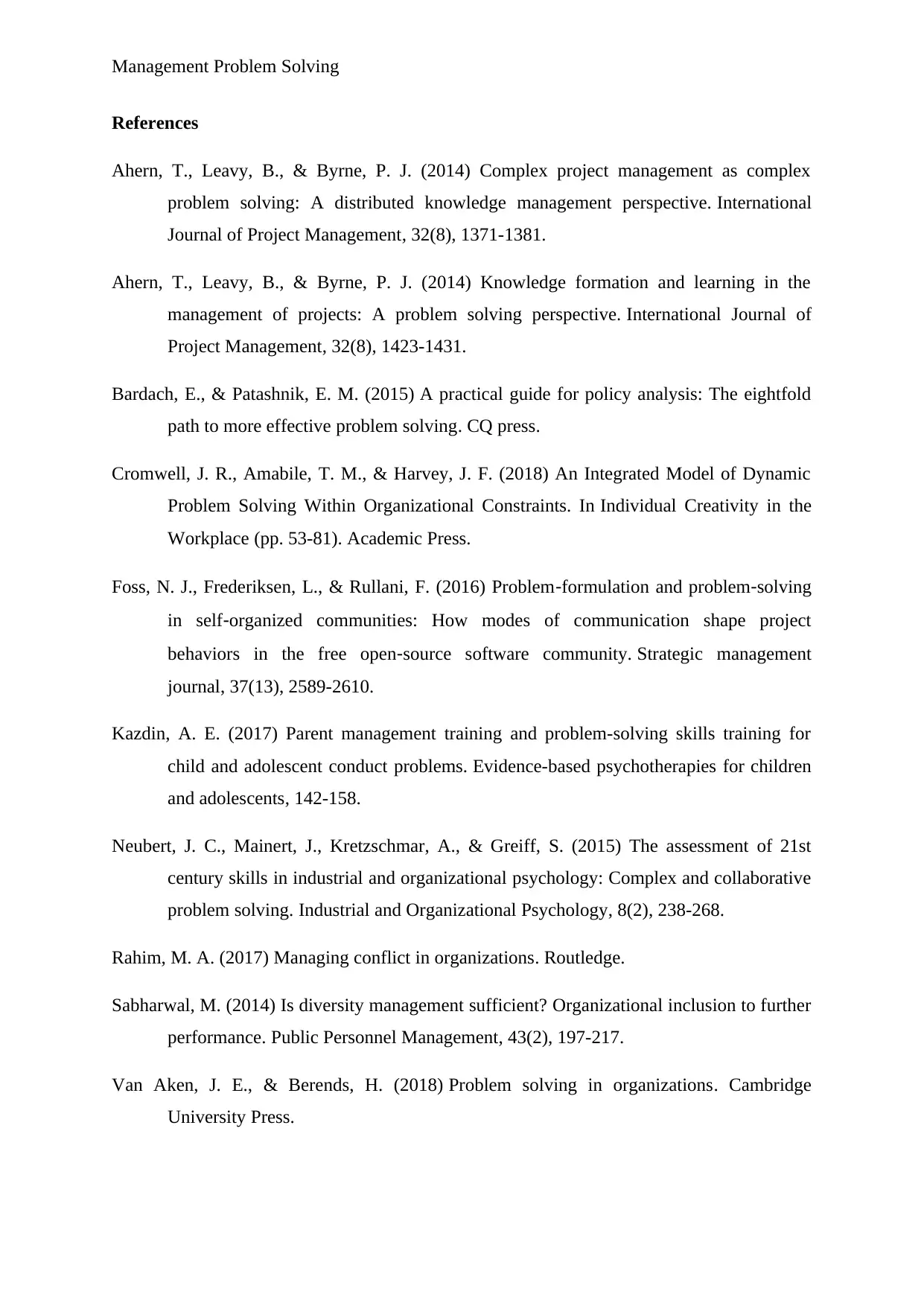
Management Problem Solving
References
Ahern, T., Leavy, B., & Byrne, P. J. (2014) Complex project management as complex
problem solving: A distributed knowledge management perspective. International
Journal of Project Management, 32(8), 1371-1381.
Ahern, T., Leavy, B., & Byrne, P. J. (2014) Knowledge formation and learning in the
management of projects: A problem solving perspective. International Journal of
Project Management, 32(8), 1423-1431.
Bardach, E., & Patashnik, E. M. (2015) A practical guide for policy analysis: The eightfold
path to more effective problem solving. CQ press.
Cromwell, J. R., Amabile, T. M., & Harvey, J. F. (2018) An Integrated Model of Dynamic
Problem Solving Within Organizational Constraints. In Individual Creativity in the
Workplace (pp. 53-81). Academic Press.
Foss, N. J., Frederiksen, L., & Rullani, F. (2016) Problem‐formulation and problem‐solving
in self‐organized communities: How modes of communication shape project
behaviors in the free open‐source software community. Strategic management
journal, 37(13), 2589-2610.
Kazdin, A. E. (2017) Parent management training and problem-solving skills training for
child and adolescent conduct problems. Evidence-based psychotherapies for children
and adolescents, 142-158.
Neubert, J. C., Mainert, J., Kretzschmar, A., & Greiff, S. (2015) The assessment of 21st
century skills in industrial and organizational psychology: Complex and collaborative
problem solving. Industrial and Organizational Psychology, 8(2), 238-268.
Rahim, M. A. (2017) Managing conflict in organizations. Routledge.
Sabharwal, M. (2014) Is diversity management sufficient? Organizational inclusion to further
performance. Public Personnel Management, 43(2), 197-217.
Van Aken, J. E., & Berends, H. (2018) Problem solving in organizations. Cambridge
University Press.
References
Ahern, T., Leavy, B., & Byrne, P. J. (2014) Complex project management as complex
problem solving: A distributed knowledge management perspective. International
Journal of Project Management, 32(8), 1371-1381.
Ahern, T., Leavy, B., & Byrne, P. J. (2014) Knowledge formation and learning in the
management of projects: A problem solving perspective. International Journal of
Project Management, 32(8), 1423-1431.
Bardach, E., & Patashnik, E. M. (2015) A practical guide for policy analysis: The eightfold
path to more effective problem solving. CQ press.
Cromwell, J. R., Amabile, T. M., & Harvey, J. F. (2018) An Integrated Model of Dynamic
Problem Solving Within Organizational Constraints. In Individual Creativity in the
Workplace (pp. 53-81). Academic Press.
Foss, N. J., Frederiksen, L., & Rullani, F. (2016) Problem‐formulation and problem‐solving
in self‐organized communities: How modes of communication shape project
behaviors in the free open‐source software community. Strategic management
journal, 37(13), 2589-2610.
Kazdin, A. E. (2017) Parent management training and problem-solving skills training for
child and adolescent conduct problems. Evidence-based psychotherapies for children
and adolescents, 142-158.
Neubert, J. C., Mainert, J., Kretzschmar, A., & Greiff, S. (2015) The assessment of 21st
century skills in industrial and organizational psychology: Complex and collaborative
problem solving. Industrial and Organizational Psychology, 8(2), 238-268.
Rahim, M. A. (2017) Managing conflict in organizations. Routledge.
Sabharwal, M. (2014) Is diversity management sufficient? Organizational inclusion to further
performance. Public Personnel Management, 43(2), 197-217.
Van Aken, J. E., & Berends, H. (2018) Problem solving in organizations. Cambridge
University Press.
⊘ This is a preview!⊘
Do you want full access?
Subscribe today to unlock all pages.

Trusted by 1+ million students worldwide

Management Problem Solving
Van Aken, J. E., & Berends, H. (2018) Problem solving in organizations. Cambridge
University Press.
Wheelen, T. L., Hunger, J. D., Hoffman, A. N., & Bamford, C. E. (2017) Strategic
management and business policy. pearson.
Van Aken, J. E., & Berends, H. (2018) Problem solving in organizations. Cambridge
University Press.
Wheelen, T. L., Hunger, J. D., Hoffman, A. N., & Bamford, C. E. (2017) Strategic
management and business policy. pearson.
1 out of 7
Related Documents
Your All-in-One AI-Powered Toolkit for Academic Success.
+13062052269
info@desklib.com
Available 24*7 on WhatsApp / Email
![[object Object]](/_next/static/media/star-bottom.7253800d.svg)
Unlock your academic potential
Copyright © 2020–2025 A2Z Services. All Rights Reserved. Developed and managed by ZUCOL.




